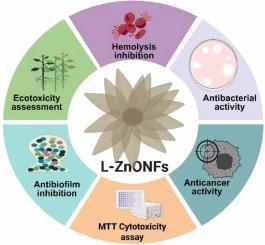木质素制备的纳米氧化锌花颗粒及其抑菌活性、抗生物膜活性、体外抗癌活性和对种子萌发的毒性
IF 6.2
1区 农林科学
Q1 AGRICULTURAL ENGINEERING
引用次数: 0
摘要
纳米科学目前正在研究利用植物提取物合成金属/金属氧化物纳米粒子(NPs)。这种方法非常有前途,与传统方法相比有许多优点。目前的研究是利用木质素制造的氧化锌(L-ZnO)制备生态友好且经济高效的生物纳米复合材料,由于其独特的物理和化学性质,它被认为是一种有价值的处理方案。ZnONFs的紫外可见吸收峰在375 nm处达到最大吸收。显微镜技术,如场发射扫描电子显微镜(FE-SEM)和高分辨率透射电子显微镜(HR-TEM)描述了纳米花的精确形态特征。TEM图像显示花瓣状结构,花瓣边缘直径为202.23 ± 23.41 nm,长度为281.69 ± 49.04 nm。对HepG2细胞进行细胞活力试验,结果表明,3-(4,5-二甲基噻唑-2-基)-2,5-二苯基溴化四唑(MTT)中L-ZnONFs的浓度与细胞活力成正比降低,IC50值为135 ± 6.75 μg/mL。Annexin V荧光活化细胞分选(FACS)分析证实L-ZnONFs诱导HepG2细胞凋亡。抑菌实验结果表明,合成的L-ZnONFs对革兰氏阴性菌(大肠杆菌、肺炎克雷伯菌和typi沙门氏菌)的抑菌效果优于革兰氏阳性菌(白喉杆菌)。L-ZnONFs对白喉支原体也有明显的抗生物膜作用。此外,还评价了L-ZnONFs对萝卜发芽和生长的影响,强调了其作为可持续农药的可能性。这些结果表明,木质素修饰的L-ZnONFs具有抗癌和抗菌的特性,可用于治疗和农业领域。本文章由计算机程序翻译,如有差异,请以英文原文为准。

Lignin produced nano zinc oxide flower particles and their antimicrobial, antibiofilm, invitro anticancer activity and toxicity on seed germination
Nanoscience is currently investigating the use of plant extracts to synthesize metal/metal oxide nanoparticles (NPs). This approach is extremely promising, offering many advantages over conventional methods. The current investigation deals with eco-friendly and cost-effective bio nanocomposites were prepared using lignin-fabricated zinc oxide (L-ZnO), which is recognized as a valuable compound in the treatment regime due to its unique physical and chemical properties. UV visible absorption peak for ZnONFs shows the maximum absorption at a wavelength of 375 nm. Microscopy techniques such as field emission scanning electron microscopy (FE-SEM) and high-resolution transmission electron microscopy (HR-TEM) described precise morphological characteristics of nanoflowers. A TEM image shows flower-like structures, petal edges with 202.23 ± 23.41 nm in diameter, and 281.69 ± 49.04 nm in a length. A cell viability test performed on HepG2 cells shows a decrease in cell viability in proportion to the concentration of L-ZnONFs in 3-(4,5-dimethylthiazol-2-yl)-2,5-diphenyltetrazolium bromide (MTT) with an IC50 value of 135 ± 6.75 μg/mL. Fluorescence-Activated Cell Sorting (FACS) analyses using Annexin V confirmed that L-ZnONFs induced apoptosis in HepG2 cells. Antimicrobial results demonstrated that the synthesized L-ZnONFs were more effective against Gram-negative bacteria (E.coli, K.pneumoniae, and S.typi) than Gram-positive bacteria (C. diphtheriae). The L-ZnONFs also demonstrated significant anti-biofilm effects in C. diphtheriae. In addition, L-ZnONFs were assessed for their impact on germination and growth in Raphanus sativus (radish), emphasizing their possibility as sustainable agrochemicals. These verdicts demonstrated that L-ZnONFs modified with lignin possess anticancer, and antibacterial properties, and can be used for therapeutic and agriculture field.
求助全文
通过发布文献求助,成功后即可免费获取论文全文。
去求助
来源期刊

Industrial Crops and Products
农林科学-农业工程
CiteScore
9.50
自引率
8.50%
发文量
1518
审稿时长
43 days
期刊介绍:
Industrial Crops and Products is an International Journal publishing academic and industrial research on industrial (defined as non-food/non-feed) crops and products. Papers concern both crop-oriented and bio-based materials from crops-oriented research, and should be of interest to an international audience, hypothesis driven, and where comparisons are made statistics performed.
 求助内容:
求助内容: 应助结果提醒方式:
应助结果提醒方式:


